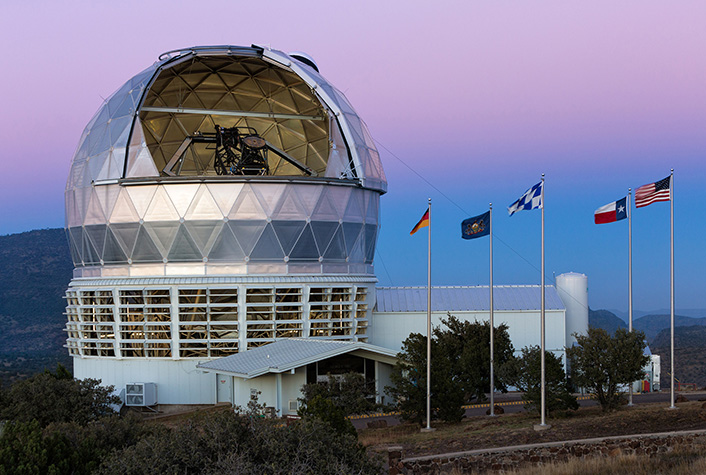Largest-ever cosmic map: Project uses A&M-built device to collect data

Three years into its quest to reveal the nature of dark energy, the Hobby-Eberly Telescope Dark Energy Experiment (HETDEX) led by The University of Texas at Austin and involving Texas A&M University is on track to complete the largest map of the cosmos ever — a three-dimensional map of 2.5 million galaxies that will help astronomers understand how and why the expansion of the universe is speeding up over time.
The survey began in January 2017 on the 10-meter Hobby-Eberly Telescope (HET) at McDonald Observatory. Today, the survey is 38 percent complete. Data reduction and analysis are continuing.
The survey works by aiming the telescope at two regions of the sky near the Big Dipper and Orion. For each pointing, the telescope records around 32,000 spectra, capturing the cosmic fingerprint of the light from every object within the telescope’s field of view.
These spectra are recorded via 32,000 optical fibers that feed into more than 100 instruments working together as one. This assembly is called VIRUS, the Visible Integral-field Replicable Unit Spectrograph. It’s a massive machine made up of dozens of copies of an instrument working together for efficiency.
The first-of-its-kind VIRUS instrument was assembled and aligned in Texas A&M’s Charles R. ’62 and Judith G. Munnerlyn Astronomical Laboratory under the direction of Texas A&M astronomer Darren DePoy, holder of the Rachal-Mitchell-Heep Endowed Professorship in Physics in the Texas A&M Department of Physics and Astronomy and member of the George P. and Cynthia Woods Mitchell Institute for Fundamental Physics and Astronomy. DePoy spearheaded the challenging construction of no fewer than 192 individual VIRUS units — each an identical copy of a single spectrograph, and each containing a bundle of about 230 optical fibers individually designed to focus on a tiny piece of the sky — as well as the assembly and testing of the overall instrument along with fellow Texas A&M astronomer Jennifer Marshall.
DePoy notes the VIRUS concept is a first in astronomy, not only in terms of its function in the revolutionary HETDEX project but also its utilization of industrial replication, which he estimates saved about 75 percent of the cost that would have been required to build a single spectrograph big enough to do the job.
“We are fortunate at Texas A&M to have both the excellent students and staff as well as the high-quality lab space required to build such precision instrumentation,” said DePoy, who also serves as associate dean for research in the Texas A&M College of Science. “All of us are excited to be part of such a groundbreaking project as VIRUS and HETDEX.”

